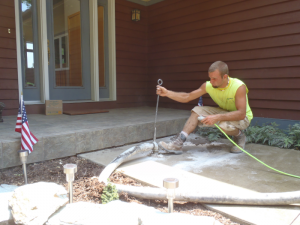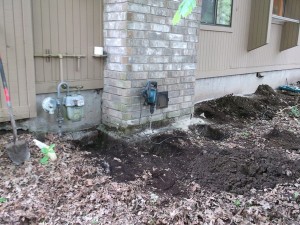Concrete Foundation Repair Methods
In the past, a number of different techniques were used to repair sunken concrete. Steel, cement, concrete and wood have all been poured, turned, pushed or forced down into the ground in order to attempt to save these slabs and foundations. The majority of these repairs proved ineffective, a complete waste of time and money.
Some of the methods that are more successful for remediation involve a significant disruption of a business or family that is in the building. In most cases, it is more desirable for the settlement of monolithic foundations and building slabs in a residential area to be fixed without requiring all of the appliances, furniture, and in some cases the entire family, to be moved, or in a commercial area, without upsetting the flow of the business.

The good news is that with the innovative technology and experienced experts present today, there are quite a few extremely successful solutions for the issue of sunk concrete, which involve very little, or even no disruption at all, to the business or living routine.
Common methods for fixing slabs
There are two common methods for repair foundations and slabs:
Slabjacking

This is when grout will be pumped underneath the slab or a beam in order to lift the slab and restore it to its prior location.
Piering

This is when steel posts will be driven into soil that is unstable and a hydraulic jack is then used to stabilize or raise the concrete slab, which has been altered by changes that are present in the soil underneath.
The type of issue that is present will determine which repair solution is right:
Select the right repair option
Prior to selecting the proper repair method, it is important to determine the underlying cause. If you call a professional, they will examine the trim boards, moldings, brick veneer mortar joints and the windows in lower locations for any clues. You should also be aware of any recent weather conditions. In a number of cases, wet or dry weather may cause issues in the soil beneath the foundation.
The method that is used most often for correcting a smaller slab of sunk concrete, including swimming pool decks, sidewalks, driveways and residential slabs is slabjacking. This process works by pumping cement grout into small holes that are drilled into the damaged slab. After the grout is in the proper position, it will solidify into a mass and provide a competent and strong bearing under the entire slab.
If there is a grout with lime used, then the lime will help to add stabilization under the base, or the sub-base. As a result, this along with the proper treatment will help to restore the slab to its proper grade and will also stabilize the soil underneath in order to ensure the issue does not occur again.
If there is a larger issue problem, especially the ones that are found in commercial buildings or homes, piering will be used, since it is able to life and also stabilize the entire foundation.
When it comes to your home or building foundation, you cannot afford to take chances. You need to call out a professional if you believe an issue is present. Doing so will help ensure the problem is fixed quickly and properly the first time. If you allow the problem to persist, it will only become worse, and cost more to have repaired in the long run. Be sure to take note of any signs that there may be an issue, such as cracks in the walls and doors that do not shut properly. Doing so will ensure you get service before the problem becomes worse.

